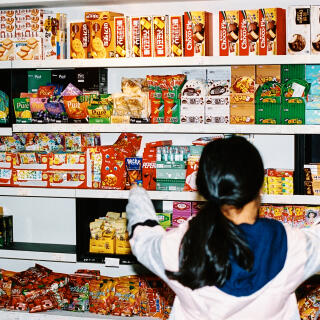


Korea's soft power: K-food aims for the taste buds
FeatureKorean cuisine − spicy, colorful and not too hard to reproduce at home − is pouring onto our plates. Popularized by TV series and K-pop, the cuisine is winning over young French adults, who are finding it in restaurants and grocery stores all over town.

On Rue de Provence, not far from the Saint-Lazare train station in the 9th arrondissement of Paris, a trio of young folks came out at lunchtime to grab their little slice of Korea at K-Mart, the grocery store recognized by its logo of an orange capital K on a charcoal-gray background. Opened in April, it is the latest of the Korean chain's five Parisian locations. "We love it. There's an incredible selection and we want to try everything," said 19-year-old Nina enthusiastically. She was interrupted by a shriek from Célia, another of the threesome: "They've got tteokbokki!"
These followers of K-pop band BTS were clustered behind a refrigerated display case, their eyes eagerly devouring a bag containing rice flour sticks, meant to be cooked in a spicy red chili-based sauce. "It's a real treat, with a taste that's both spicy and a bit sweet," said Kenza. "Should we get two packets? It goes fast..." Her friends nodded their agreement.
A cultural tsunami
They are worthy representatives for the growing number of consumers who love the flavors of hansik − Korean cuisine, and in particular the country's street food. It counts among its varieties tteokbokki; kimbap (or gimbap), rice rolls coated in seaweed and filled with all sorts of ingredients; bibimbap, a dish mixing rice, vegetables, egg and marinated meat; and corn dog, a sausage coated in a deep-fried batter and skewered on a stick. These delicacies are well known to a generation brought up on K-pop music and movies and K-dramas from the "land of the morning calm."
The tsunami has hit the restaurant scene and is now filling carts, pans and microwaves. In the space of just a few years, the number of Korean restaurants has doubled to almost 300 in Paris and the wider region, with another 80 or so in outlying areas. And that's not counting those "Chinese" restaurants that, having previously offered pseudo-Japanese cuisine, have been expanding their menus to include Korean dishes. In line with this trend, grocery stores and mini-markets have been popping up everywhere.
In Paris, K-Mart and Ace Mart (also with five supermarkets in the capital), which have their own online service providing deliveries throughout France, are the flagships for a fleet of smaller stores based in Lille, Lyon, Marseille, Bordeaux, Nice and Dijon. These hubs of Korean (and a smattering of Japanese) food offer a superabundance of condiments, noodles, sweets and drinks that bring delight to a large number of 20-somethings, mostly young women, swept up in the hallyu − a word of Chinese origin meaning "Korean wave." Having arrived in Europe about a decade ago from Seoul, this cultural phenomenon is exemplified by the worldwide success of music groups like BTS and Blackpink.
You have 75% of this article left to read. The rest is for subscribers only.
